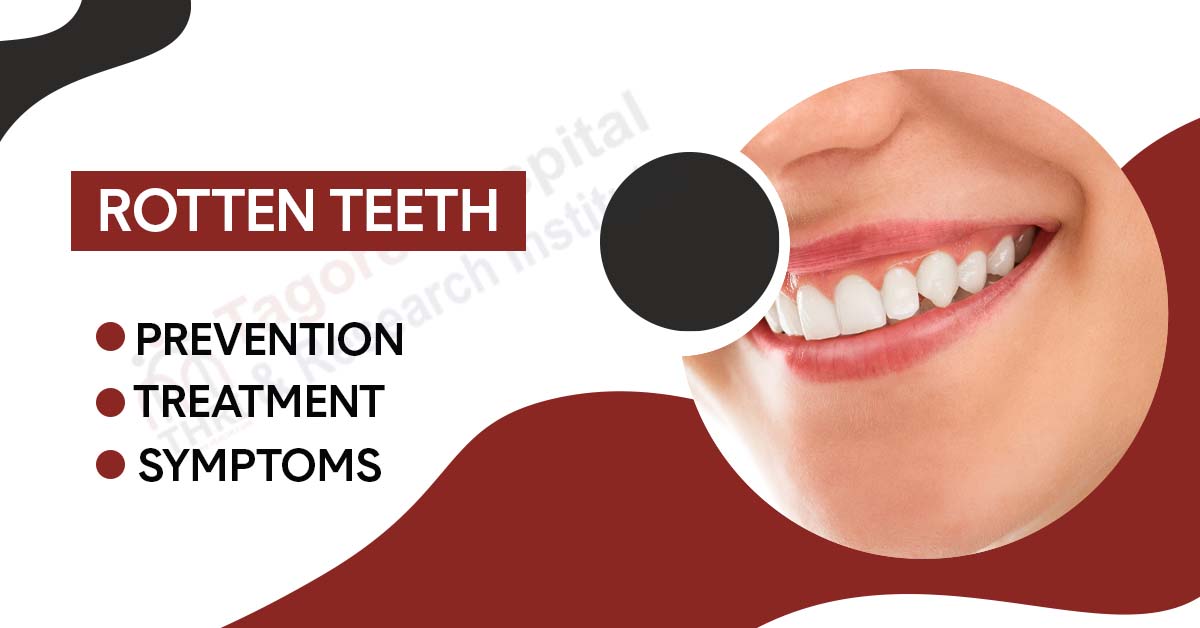- By THRI admin
- Posted December 14, 2022
A smile, healthy teeth, and healthy gums are all benefits of good oral health. On the other hand, having poor oral hygiene can increase your risk of developing tooth decay, often known as a cavity or a rotting tooth.
Plaque, a sticky, white coating that develops over the teeth, is what causes decay. Plaque is made up of bacteria, and when these bacteria combine with food sugar, they produce an acid that corrodes teeth.
It's crucial to understand the reasons and symptoms of a rotting tooth because if left untreated, a badly rotted tooth might become loose and fall out.
What are Rotten Teeth?
An individual's teeth are made up of an inner pulp layer made up of cells and nerve tissue, an inner calcified dentin layer that supports the tooth, and enamel (the outside layer or coating of the teeth).
As a result of frequent consumption of foods that are high in sugar and acid, as well as the buildup of bacteria in the mouth, your teeth or teeth can deteriorate over time. Plaques, which adhere to the teeth, are created when the resultant bacteria, acid, food, and saliva come together.
Cavities are holes in the teeth that are caused by the acids in plaques dissolving the tooth's surface. Plaque and bacteria target the softer dentin inside the tooth when the enamel is worn away, and they then go on to the pulp in the middle of the tooth.
Rotten teeth can cause an excruciatingly painful infection in the pulp, which can spread behind the tooth and into the gums if the illness is more severe. Because there may be one or several causes for rotten teeth, they can be very painful.
Poor dental hygiene, which can result in bacterial infection, weakened immune system, dry mouth, and high sugar intake, is the leading cause of rotting teeth. The bone and connective tissue that hold the teeth in place can be destroyed by periodontal disease (also known as gum disease), which is brought on by bacterial infection.
Symptoms of Rotten Teeth:
White patches on your teeth are an early sign of tooth decay and a sign of mineral loss.
Brown or dark stains, particularly towards the base of the teeth, and exposed roots below the gum line are other telltale signs of tooth decay. Additionally, there might be obvious abscesses (pockets filled with pus) or swelling in cases of severe tooth decay.
Before any obvious indicators of tooth decay are noticed, you could experience bodily problems.
Symptoms of tooth decay are as follows:
- Tooth pain
- Facial swelling
- Fever
- Staining on your teeth
- Cavities (dental caries)
- Infections or abscesses
- Tooth Sensitivity
Causes of Rotten Teeth:
There are several potential explanations for rotting teeth rather than just one. Understanding the causes of tooth decay might help you keep your teeth healthy in the future.
Poor dental hygiene:
To maintain your teeth strong and healthy and to remove plaque, you must brush and floss frequently. You should floss every day and brush your teeth at least twice a day. Additionally, schedule expert dental cleanings twice a year at the dentist.
Poor diet:
Since these foods stick to the teeth, eating a diet high in sugar and carbs can also hasten tooth decay. Additionally, sugar feeds bacteria, and the more bacteria you have in your mouth, the more acid there is.
The outer coating of your teeth, known as the tooth enamel, may wear down more quickly if you consume a lot of sugary foods and neglect to brush them. Similar to how excessive consumption of acidic beverages (such as soda and juices) and acid reflux disorders can lead to tooth damage.
The acid in drinks has the potential to slowly erode tooth enamel. Stomach acid reflux can erode tooth enamel because it flows back into the mouth and esophagus.
Dry mouth:
Your mouth may have more plaque and acid if your salivary glands aren't producing enough saliva to help wash away bacteria and plaque, which could lead to tooth decay or rot.
Dental crevices:
Deep dental crevices can contribute to tooth decay. These groves can make it more difficult to brush effectively, and if plaque builds up in them, it can erode the surface of your tooth. Plaque accumulation on healthy teeth may be avoided by applying a dental sealant.
Fluoride deficiency:
Fluoride is a mineral that occurs naturally and can fortify tooth enamel, making it more resistant to cavities. Although it is occasionally present in bottled water, fluoride is typically added to public water supplies. You run the risk of developing tooth decay if you don't use fluoride-containing toothpaste or if you don't drink the city's water supply.
Baby bottle:
If your child sleeps with a bottle of milk, juice, or formula in their mouth, or if you dip their pacifier in sugar or honey, tooth decay may also start developing in their mouths at a young age. Both situations can result in tooth decay due to sugar buildup around the teeth.
Diagnosis of Rotten Teeth:
- By having regular dental checkups, tooth decay can be identified early. The development of plaque and early stages of tooth decay are closely inspected. Additionally, the gums are thoroughly examined for signs of gum involvement during the examination.
- The patient's dietary habits, oral hygiene practices, and history of any tooth decay or dental issues are all thoroughly recorded.
- You could also use an X-ray or bitewing radiograph to look for tooth decay. Small lesions of tooth decay that have not yet resulted in cavities or holes can be found with these X-rays. However, it is not advised to use bitewing X-rays as a technique for screening for caries in all children seeing the dentist.
- To determine the type of cavity, an X-ray can be used. These cavities include pit cavities, which develop in the molars and can quickly affect the entire tooth, smooth surface cavities, which develop over the flat side surfaces of the teeth, and root cavities, which develop in the tooth's root below the gumline.
- Other less popular diagnostic methods include the use of electric caries meters, laser fluorescence, and temporary tooth separation.
Prevention of Rotten Teeth:
While rotten teeth will need to be treated, it is possible to stop them from happening. Prevention is the best course of action when battling many dental conditions. By maintaining excellent oral health, you essentially give yourself the best chance.
The following are techniques for encouraging healthy teeth and gums:
- Floss and brush your teeth regularly: Regular brushing can stop tooth decay, gum disease, and a host of other issues. For healthy teeth and gums, use fluoride toothpaste while brushing and flossing frequently.
- Have regular checkups: Many people struggle with dental phobias, which may prevent them from visiting the dentist. Even if you hate going to the dentist, it's important to receive frequent exams to catch problematic teeth and gum problems early.
- Avoid problem foods and drinks: Avoiding starchy or sugary foods and beverages is beneficial for both children and adults. Cavities in the mouth can be prevented by limiting the intake of carbonated drinks, chips, and sweets.
The techniques mentioned above stop a wide range of dental problems. Preventing rotten teeth is crucial if you have an underlying medical condition because an infection could put you at risk for serious complications.
Treatment of Rotten Teeth:
Before the onset of bothersome symptoms and the development of more serious issues, routine examinations can detect cavities and other dental conditions. Your chances of stopping tooth decay in its tracks and reversing its early stages are better the earlier you seek treatment. You usually won't need significant treatment if you address a cavity before it starts to hurt.
The severity of your cavities and your unique situation will determine how they should be treated. Treatment options include:
- Fluoride treatments. Fluoride treatments sometimes help restore tooth enamel and can even stop a cavity in its earliest stages if it has only recently begun. Professional fluoride treatments have a higher fluoride content than tap water, toothpaste, or mouthwash. Fluoride treatments come in a variety of forms that can be applied to your teeth or placed in a tiny tray that fits over them. They can be liquid, gel, foam, or varnish.
- Fillings. When decay has advanced past the early stages, fillings, also known as restorations, are the primary treatment choice. Dental amalgam, which is a mixture of several materials, tooth-colored composite resins, porcelain, and other materials are used to make fillings.
- Crowns. A crown, a specially fitted covering that replaces the entire natural crown of your tooth, may be necessary for severely decayed or weak teeth. A sufficient amount of healthy tooth structure is removed by your dentist's drill in addition to the entire decayed area. Crowns can be made of various materials, including gold, high-strength porcelain, resin, porcelain fused to metal, and porcelain.
- Root canals. You might require a root canal if decay has spread to the pulp, which is the inner part of your tooth. A severely decayed or damaged tooth can be treated with this procedure to save it rather than extracting it. The diseased tooth pulp is removed. To eliminate any infection, medication is occasionally injected into the root canal. The filling is then applied in place of the pulp.
- Tooth extractions. Some teeth develop severe decay to the point where they cannot be repaired and must be extracted. A gap left by a tooth extraction might encourage your other teeth to move. If you can, think about replacing the missing tooth with a bridge or a dental implant.
Tags





